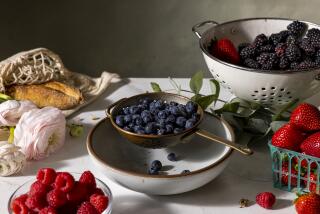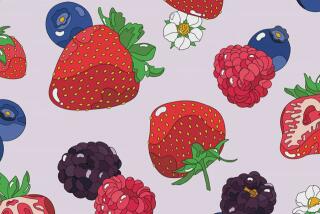The secret life of jelly beans

- Share via
AH, the colors of spring -- bright red, blazing yellow and vivid green; deep purple, brilliant blue, pink dashed with scarlet -- all scattered around in little semi-orbs, like the eggs of impossibly brilliant birds. This is the season of the jelly bean.
And it’s getting baroque in bean land. Forget plain lemon and cherry. You can get assortments in as many as 50 flavors -- including margarita -- or you can order a single flavor (say French vanilla) by the pound. There are “extreme” jelly beans with flavors such as garlic, for those who want to go there. We seem to be approaching the limits of what you can do with sugar, cornstarch and a vivid imagination.
That’s right, sugar and cornstarch. Make no mistake, a jelly bean contains no jelly. The Beatles found this out the hard way.
In the ‘60s, American fans, having read that the rockers liked Jelly Babies, lovingly pelted their idols with jelly beans, under the impression that they were the same thing. Not so. Jelly Babies are soft, made out of thickened jelly. Jelly beans have a hard sugar coating. Ouch.
The “jelly” part of a jelly bean is actually what we call Turkish delight, a gently chewy cornstarch-thickened sweet that was created by an Istanbul confectioner in 1777. It reached America in the late 19th century.
That happened to be a time when there was a craze -- particularly among children -- for penny candies. (They weren’t necessarily a penny apiece -- 10 cents would get you a 1-pound bag of gumdrops.)
Some unknown American candy maker had the bright idea of making a penny-candy version of Turkish delight by cutting it into tiny pieces and giving them a hard candy coating. The sugar coating protected the soft interior from dirt and created something you could carry in your pocket.
The original versions were probably cylindrical, more or less, but candy makers early on started making them in the innocently amusing shape of a bean. Jelly beans were being sold under that name at least by the 1890s.
They were too complicated for home candy makers, who stuck with their easy caramels, divinities, nut brittles and chocolates. Sugar coating, that textural key to jelly beans, requires special equipment. You moisten the bean centers with sugar syrup and toss them around in a gadget that looks like a stainless-steel cement mixer. The colliding beans beat the sugar into a thin, smooth candy coating as they dry.
This process has the odd name “panning,” because the cement mixer thing is technically known as a dragée pan, dragée being the French term for sugar-coated nuts. The Jelly Belly company refers to it as an engrossing pan. No matter what you call it, it doesn’t really look much like a pan.
And making the filling is even more troublesome because you have to give it the proper shape. This is done by punching bean-shaped holes into a tray of cornstarch and dropping hot, semi-liquid Turkish delight into them. After a couple of days, the bean centers will have dried and hardened enough to be “panned.”
Like all panned sweets, a jelly bean needs several layers of candy coating. Until Jelly Belly introduced the flavored fillings in 1976, the filling and most of the coating were plain, and only the last layer of the coating contained any flavor or coloring.
Such cute colors
BUT the candies’ appeal from the start was in their bright colors as much as their flavor. With their rainbow of hues and smooth, featureless surfaces, jelly beans gave the 1920s a slang term for a sharp-dressing but insubstantial young man. There was a pop song about it: “Jelly Bean (He’s a Curbstone Cutie).”
Also in the ‘20s, people started putting bright, cheery jelly beans in Easter baskets, and by the ‘40s the association with Easter was thoroughly settled. These days, no self-respecting Easter Bunny would dare visit without leaving jelly beans.
It looks as if jelly beans have partly usurped the place of the traditional Easter egg as the brightest-colored food of the holiday. And from a kid’s point of view, the logic is inescapable. Sure, it’s great, messy fun to dye eggs, but who’d rather eat a hard-boiled egg than a piece of candy?
More to Read
Sign up for The Wild
We’ll help you find the best places to hike, bike and run, as well as the perfect silent spots for meditation and yoga.
You may occasionally receive promotional content from the Los Angeles Times.










